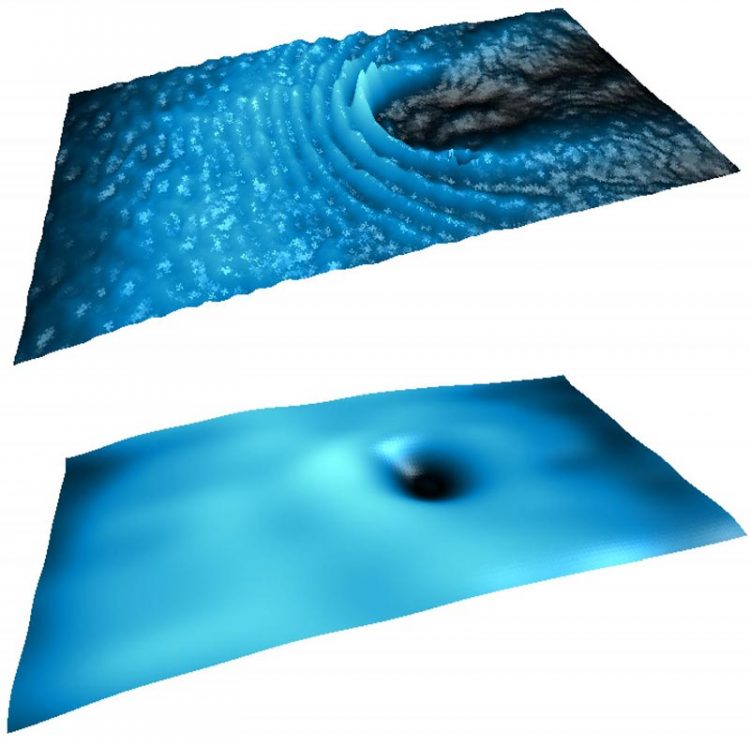A stream of superfluid light

The flow of polaritons encounters an obstacle in the supersonic (top) and superfluid (bottom) regime. Credit: Polytechnique Montreal
Researchers from CNR NANOTEC of Lecce in Italy, in collaboration with Polytechnique Montreal in Canada have shown that for light “dressed” with electrons, an even more dramatic effect occurs. Light become superfluid, showing frictionless flow when flowing across an obstacle and reconnecting behind it without any ripples.
Daniele Sanvitto, leading the experimental research group that observed this phenomenon, states that “Superfluidity is an impressive effect, normally observed only at temperatures close to absolute zero (-273 degrees Celsius), such as in liquid Helium and ultracold atomic gasses.
The extraordinary observation in our work is that we have demonstrated that superfluidity can also occur at room-temperature, under ambient conditions, using light-matter particles called polaritons.”
“Superfluidity, which allows a fluid in the absence of viscosity to literally leak out of its container”, adds Sanvitto, “is linked to the ability of all the particles to condense in a state called a Bose-Einstein condensate, also known as the fifth state of matter, in which particles behave like a single macroscopic wave, oscillating all at the same frequency.
Something similar happens, for example, in superconductors: electrons, in pairs, condense, giving rise to superfluids or super-currents able to conduct electricity without losses.”
These experiments have shown that it is possible to obtain superfluidity at room-temperature, whereas until now this property was achievable only at temperatures close to absolute zero. This could allow for its use in future photonic devices.
Stéphane Kéna-Cohen, the coordinator of the Montreal team, states: “To achieve superfluidity at room temperature, we sandwiched an ultrathin film of organic molecules between two highly reflective mirrors. Light interacts very strongly with the molecules as it bounces back and forth between the mirrors and this allowed us to form the hybrid light-matter fluid.
In this way, we can combine the properties of photons such as their light effective mass and fast velocity, with strong interactions due to the electrons within the molecules. Under normal conditions, a fluid ripples and whirls around anything that interferes with its flow. In a superfluid, this turbulence is suppressed around obstacles, causing the flow to continue on its way unaltered”.
“The fact that such an effect is observed under ambient conditions”, says the research team, “can spark an enormous amount of future work, not only to study fundamental phenomena related to Bose-Einstein condensates with table-top experiments, but also to conceive and design future photonic superfluid-based devices where losses are completely suppressed and new unexpected phenomena can be exploited”.
###
These experiments are published today in the June 5th issue of Nature Physics and are the result of work carried out at the Advanced Photonics Laboratories of the Institute of Nanotechnology of the Italian National Research Council in Lecce, in collaboration with Polytechnique Montreal in Canada, the Center of Excellence at Aalto University in Finland and Imperial College London.
Reference:
“Room-temperature superfluidity in a polariton condensate”,
G. Lerario, A. Fieramosca, F. Barachati, D. Ballarini, K. S. Daskalakis, L. Dominici, M. De Giorgi, S. A. Maier, G. Gigli, S. Kéna-Cohen, D. Sanvitto,
(2017) Nature Physics, in press.
Media Contact
All latest news from the category: Physics and Astronomy
This area deals with the fundamental laws and building blocks of nature and how they interact, the properties and the behavior of matter, and research into space and time and their structures.
innovations-report provides in-depth reports and articles on subjects such as astrophysics, laser technologies, nuclear, quantum, particle and solid-state physics, nanotechnologies, planetary research and findings (Mars, Venus) and developments related to the Hubble Telescope.
Newest articles

First-of-its-kind study uses remote sensing to monitor plastic debris in rivers and lakes
Remote sensing creates a cost-effective solution to monitoring plastic pollution. A first-of-its-kind study from researchers at the University of Minnesota Twin Cities shows how remote sensing can help monitor and…

Laser-based artificial neuron mimics nerve cell functions at lightning speed
With a processing speed a billion times faster than nature, chip-based laser neuron could help advance AI tasks such as pattern recognition and sequence prediction. Researchers have developed a laser-based…

Optimising the processing of plastic waste
Just one look in the yellow bin reveals a colourful jumble of different types of plastic. However, the purer and more uniform plastic waste is, the easier it is to…


